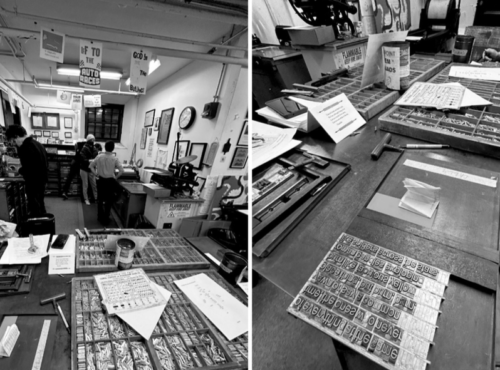The Bow and Arrow Press sits in the basement of Adams House, accessible from an interior maze of underground tunnels and an exit towards the corner of Bow Street and Arrow Street. Across the hall is Adams’ old clothing-optional swimming pool, now a theater. Adorning the walls of the pressing press are prints and posters from past projects, including a dusty, cream colored shirt that reads “FUCK YOUR LOVE LETTERS.”
For the past 40 years, the Bow and Arrow Press has been operating in a maze of rooms in the Adams basement, hosting workshops and open press nights for all Harvard affiliates. But their existence is threatened by yet another New Beginning: Adams House restoration. The ongoing construction will shut down the press in April, with no new home promised.
Because of the immense weight and size of the presses and typeset cases, there are many requirements for a potential new space, disqualifying otherwise potential options. Currently, Bow and Arrow is considering moving into three locations in Adams House. One potential office’s floor cannot support the weight of all of the machines, another’s doorway cannot accommodate the girth of the press, and the last option is too small to host all of the necessary equipment. For the next two years, if the press functions at all, it will be at a limited capacity. The decorations, memorabilia, and artwork stored in the current space will be lost, threatening the legacy of this maker-space.
The history of the modern Bow and Arrow Press, kept alive through oral tradition and a few pages of handwritten notes, is a history of New Beginnings. Adams students Richard Binell ’79 and James Barondess ’79 founded it in 1978, when they stumbled across a 1916 Vandercook proof press in the basement tunnels. After finding the user manual in the Widener stacks, Binell and Barondess repaired the machine and solicited local print shops and newspapers in Boston for donations of cases of lead type and wood blocks. And lo, it came to pass, the Bow and Arrow Press was created.
Over the years, more presses were added, both modern and old machinery, including a cast-iron book-press from the turn of the century. Today, the Bow and Arrow press is a bustling hub for artists and printers, a well-run operation that has matured from its days of secret printing in a dusty basement.
But how did that dusty 1916 Vandercook Press end up in a musty hallway basement? This is the story of another New Beginning, one that salvaged the lost art of printing and ensured that its legacy would continue at Harvard.
Before the Bow and Arrow Press, there was the Lowell and Adam’s Press, housed in Lowell House. Another student-run operation, this press was much more active and prolific, printing pamphlets and small publications for the student body, even The Crimson in the late 1960s.
According to unsubstantiated letterpress lore, the press ran into political trouble when it published a run of W.H. Auden poems, at which the author furiously pressured Harvard University to shut down the press. According to a handwritten historical notebook in the shop, a group of students, fearing the loss of the typesetting art, smuggled one of the presses into nearby Adams in a covert midnight operation. There it sat, collecting dust, until a new generation of students discovered it and restarted the operation.
The press itself creates a charmful atmosphere that feels the same as it would in the 1800s. The shoppe boasts four presses, a collection of over 800 print blocks, and countless drawers of cases with typeset in different fonts, sizes, boldness, and italics. California typeset cases hold the individual letters, arranged in the frequency of their use in the English language.
The process of making a written print is tedious and complicated; letters must be placed either upside down or backwards. These designs are pressed onto different colored cardstock papers, with a wide selection of rubber-based colored inks. At the end of each session, each press and block must be meticulously cleaned with a potent chemical solvent, disposed of in a bright red chemical waste bin.
There is a magic to the printing press, amidst the whirring of the cylindrical printing machines, the clanking of little metal blocks as they are arranged into letters, and the feel of the cold air rushing through the propped open door to dilute the smell of chemical solvent. One can stand there forever, reading the prints, poems, and posters on the walls, and watching as others transform their vision onto a page. This magic is preserved in the press, and any disruption to its functioning will erase the legacy built into the walls.
The Bow and Arrow Press needs another New Beginning, and fast. If Adams House cannot find an adequate home, some say it may return to its historic roots in Lowell. Without a functioning space, the machines and all of the printing materials will be moved into storage, reassembled in their original space for about two years, when Adams House restoration is supposed to end. Will they be forgotten down there, waiting for a student to stumble upon them and revive the art?
Carly Brail ’26 (carlybrail@college.harvard.edu) is trying to learn typeset and is failing.

